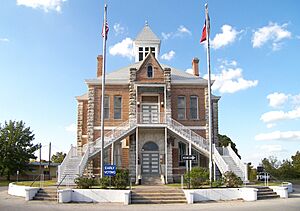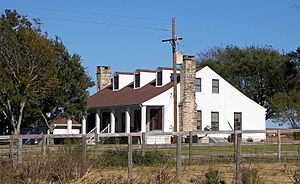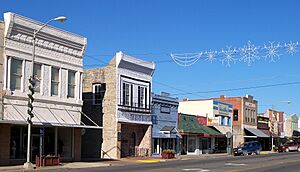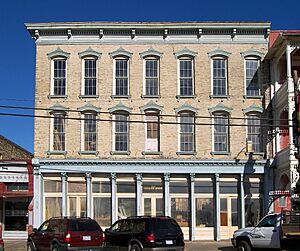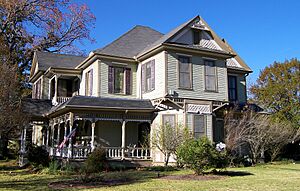National Register of Historic Places listings in Grimes County, Texas facts for kids
Welcome to Grimes County, Texas! Did you know that some places here are so special and old that they are officially recognized as important parts of history? This article will tell you about the buildings and areas in Grimes County that are listed on the National Register of Historic Places.
The National Register of Historic Places is like a special list kept by the United States government. It helps protect buildings, sites, and objects that are important to American history, architecture, archaeology, engineering, or culture. When a place is on this list, it means it has a unique story to tell about the past.
In Grimes County, there are two large historic areas (called "districts") and four individual properties that are on this important list. Some of these places are also recognized by Texas as "Recorded Texas Historic Landmarks," which means they are very special to the state's history too! One of the districts even has a "State Historic Site" and "State Antiquities Landmarks," showing just how much history is packed into these spots.
Contents
Historic Places in Grimes County
Grimes County is home to several amazing historic sites. Let's explore some of them!
Anderson Historic District
The Anderson Historic District was added to the National Register on March 15, 1974. This entire area in the town of Anderson is considered historic. It includes many old buildings and homes that show what life was like long ago. The district helps preserve the unique character and history of Anderson, which is the county seat of Grimes County. You can see beautiful old architecture here, including the historic Grimes County Courthouse.
Foster House
The Foster House was listed on the National Register on September 8, 1980. This old house is located just east of Navasota. It is a great example of the homes built in this area many years ago. Preserving houses like the Foster House helps us understand how people lived and built their homes in the past.
The Navasota Commercial Historic District joined the National Register on November 30, 1982. This district covers the main business area of Navasota. It includes many historic buildings that were once shops, offices, and other businesses. Walking through this district is like taking a step back in time to see what Navasota's downtown looked like when it was first growing. The buildings here tell stories of the town's economic past and its development.
P. A. Smith Hotel
The P. A. Smith Hotel was added to the National Register on April 16, 1976. Located at 111 Railroad Street in Navasota, this building was once a busy hotel. Hotels like this were very important in the past, especially in towns like Navasota that were connected by railroads. They provided places for travelers and business people to stay. The P. A. Smith Hotel is a reminder of Navasota's role as a travel and trade hub.
Piedmont Springs Archeological Site
The Piedmont Springs Archeological Site was listed on the National Register on July 29, 1982. This site is located near Anderson. Unlike buildings, an archeological site is a place where scientists study the remains of past human activity, often buried underground. These sites can contain artifacts, tools, and other clues that help us learn about ancient cultures and how people lived thousands of years ago. Because these sites are very sensitive and need to be protected, their exact location is usually kept private.
Steele House
The Steele House was added to the National Register on June 13, 1978. You can find this historic home at 217 Brewer Street in Navasota. Like the Foster House, the Steele House is an important example of residential architecture from an earlier time. It helps us understand the history of homes and families in Navasota. Preserving old houses like the Steele House allows future generations to appreciate the unique styles and stories of the past.



